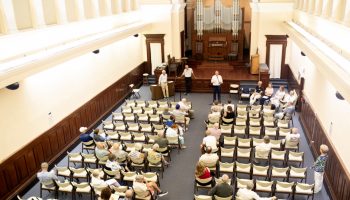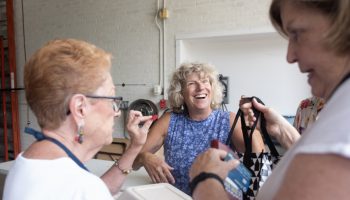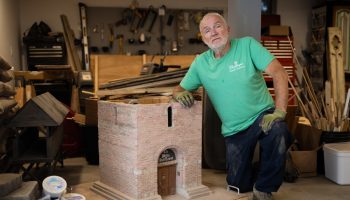
Patricia Beagle
Contributing Writer
“Why does the Bell Tower sound strange at six o’clock? Are they ever going to fix it?”
David Bigelow, chief of the Chautauqua Volunteer Fire Department, grinned and chuckled when he heard that residents have asked those questions. At 6 p.m. every day since early summer, electronic Westminster chimes ring out from the fire hall on Massey as a daily test of a new emergency warning system coinciding and overlapping with the actual chimes from the Miller Bell Tower. Bigelow pointed to the system’s six-foot siren on the roof of the truck bay.
“For daily tests, we picked the shortest, softest sound the system can make,” he said. “We would activate a regular siren sound for a working fire. If you hear that, look around. Institution buildings are equipped with fire alarms. Employees have evacuation plans for every building.”
Butch Briggs, chairman of the board of commissioners and responsible for administering CVFD funds, said the new system was a $20,000 investment. “We need to test it every day to be sure we can activate it in an emergency. It has voice capability, so we can make announcements about any emergency,” he said.

How do CVFD members know when help is needed? Thirty-five active, year-round volunteers (joined by a few who serve for at least half of the year) learn of incidents when someone calls 911. “In an emergency, do not call the fire station,” Bigelow cautioned. “Call 911.”
Paramedic Mike Volpe, chief of emergency medical services operations, added that there are also red panic buttons on the back, side and front of the fire hall, and those buttons will alarm the dispatcher.
Volpe first worked as an emergency medical technician in Chautauqua in 1996 and went on to become a paramedic.
“In 2010, the Security Department asked the CVFD to take over EMS operations,” he said. Since that time, he has led the CVFD’s EMS efforts. With dual capability, the organization can handle fire and EMS calls.
When a 911 call comes in, CVFD pagers buzz, and members rush to respond to text messages through a cell phone app called IamResponding. Responders report that they are heading to the station for equipment, are moving to the incident or are on scene. On the app, fellow team members see the status of all responders. IamResponding makes it easy to communicate within the team and to request mutual aid from other fire districts.
The CVFD handles calls well beyond the 750-acre Chautauqua grounds. The fire district includes 17.5 square miles, from Lighthouse Point Grocery to Chautauqua Lake Self-Storage on Route 394 at Magnolia Road. CVFD volunteers do not have scheduled shifts. They respond whenever needed.
On the EMS side, Volpe and a few summer paramedics are scheduled and paid. During the Summer Assembly Season, a CVFD paramedic is scheduled for duty 24/7. That person answers EMS calls with a paramedic response vehicle, also known as a fly car.
“We carry a 12-lead emergency cardiac monitor with AED; a LUCAS device for CPR chest compressions; and medications for cardiac emergencies, diabetes and allergic reactions,” Volpe said.
The fly car provides prompt response but does not transport patients. Bigelow explained that the department is also equipped with an ambulance, two pumpers, a 75-foot aerial ladder, a 4,500-gallon tanker, a pickup truck, a box utility vehicle and a golf cart.
Bigelow said the CVFD handles over 400 calls per year. “It’s about even between EMS and fire calls,” he said. “During the season, we can get 60 to 120 calls in one month.”
The most common fire calls are faulty detectors, false alarms and burned food.
“We’re going to give a cooking class,” Biglow quipped. He advises everyone to test and clean detectors and change batteries annually and to replace smoke and carbon monoxide detectors every 10 years.
Volpe noted that some of the most common EMS calls on the grounds are for falls.
“People are always in a hurry to get to a show,” he said. “We handle everything from lacerations to heart attacks. We also have those 90-degree days when nobody hydrates.”
Emergency response is serious business, and training is extensive and ongoing. Firefighter training begins with a 79-hour Basic Exterior Firefighting Operations (BEFO) course. Additional training is conducted for those who perform interior firefighting. Firefighters are also required to pass annual physicals. EMS training begins with an EMT course involving at least 150 hours of training. Further courses are available for advanced EMT and paramedic certifications.

Assistant Chief Dave Rowe, a 30-year member, leads the planning of weekly CVFD drills. Practice sessions include driver training, ambulance operations, CPR and firematics. Given the challenges of rural firefighting, members practice methods for fighting fires where there are no hydrants.
On July 22, Bigelow led 20 CVFD members in a turbo-draft drill in Miller Park to practice obtaining firefighting water from the lake. Using a supply engine, the team pumped water into Chautauqua Lake through a three-inch hose, creating a vortex. They were then able to use a five-inch hose to draw even more lake water back to the supply engine. That engine supplied lake water to a ladder truck. A hose on the extended ladder then rained down 105 gallons per minute of lake water over Children’s Beach onto squealing, frolicking children. In actual firefighting, the team could increase the flow as high as 2,000 gallons per minute.
As the CVFD executed setup, operation and equipment breakdown, a crowd watched their skills in action. Firefighter Mark Powers invited enthusiastic children to help hold and spray a ground-level hose. (Powers seemed as delighted as the little ones.) The crowd was entertained, yet the team was doing well-planned, serious work. Rowe had staged the ambulance, fly car and another fire truck just steps away from the drill, enabling quick response by members assigned to break away in the event of a call.
Billy Leone, chief of campus safety and security at Chautauqua Institution observed the operation.
“It is difficult to run this equipment. These drills give members a chance to exercise their skills,” he said.
Leone has joined the CVFD to be able to help during months when fewer responders are available. He has completed emergency vehicle operation training and plans to take the BEFO course next year. There is a bit of rivalry between safety and security and the CVFD, but it is limited to sporting events — “Boots vs. Badges” softball game will be played at 5 p.m. Sunday at Sharpe Field, and all are welcome.
Considerable ability, time and effort is involved in the work of the CVFD. Why do members get involved? Bigelow, a member since 2012, has served in CVFD leadership roles for over 10 years.
“My brother was in the fire department,” he said, “and I always wanted to join. It’s a passion to help the community.”
He also performs confined space and rope rescues on the Chautauqua County Technical Rescue Team and conducts missing person searches as a member of the Chautauqua County Search Team.
Kelly Bigelow, David’s wife of 10 years, is a paramedic with the CVFD. “My dad talked me into taking an EMT class,” she said. “I love the people we meet. I learn something new every day.”
Briggs was also drawn to service by family members.

“My uncles were involved, and I wanted to go with them on calls,” he said. “I joined at 18 to help the community, and I’ve been a volunteer for 51 years.”
In 2008, Briggs experienced an electrical fire in his own home in the town of Chautauqua: “I had a disaster, and they were there for me. My house was a total loss. Chautauqua Institution and the fire department did a fundraiser for me.”
Volpe began his EMS career in a volunteer fire department and then got a job working on ambulances in Jamestown before serving Chautauqua.
“You get through the toughest times with each other,” he said.
Volpe spent a decade serving on the board of directors of the New York State Fire Chiefs and advocating for fire departments to be allowed to recover EMS costs from insurance companies. His efforts helped achieve a vital funding change that took effect in 2022.
Mike Metzger, trustee for the CVFD, pointed out that uninsured patients never pay fire departments for EMS services, such as ambulance transportation, and there are no co-pays for insured patients.
“Funds collected from insurance companies may be used only for EMS expenses, are kept in a separate account and are monitored,” Metzger said.
Briggs pointed out that planning for equipment needs is essential, and property taxes provide an important source of funding for volunteer fire departments.
“Our budget is over $500,000 per year, and a new ladder truck today costs $1.5 to $2 million and takes two-and-a-half years to order,” he said.
The CVFD and its Auxiliary do extensive fundraising at chicken barbecues and other events, to help with expenses.
It’s always looking for new members, too, and keeps application forms at the fire station. Brandon Van Curen, a firefighter and EMT, praised the mentoring provided, while Katherine Rieck, an emergency vehicle operator, noted the rewarding work and family atmosphere where members help each other. “When my riding mower got stuck in the mud, members pulled me out,” she said.
Volpe summed up the sentiments of many, saying that “the reward is being able to help people on their worst day.”





